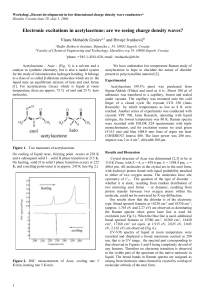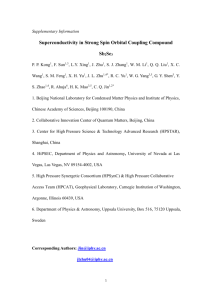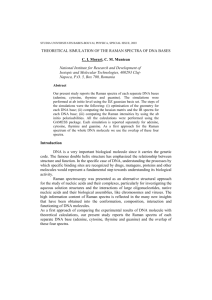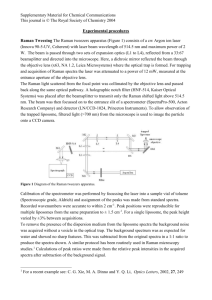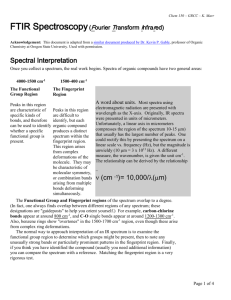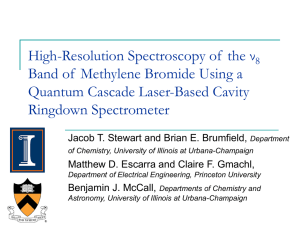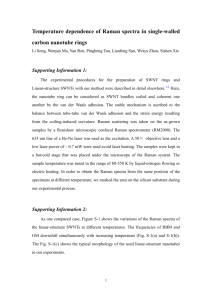hemoglobin and human blood adsorption on silver colloidal particles
advertisement
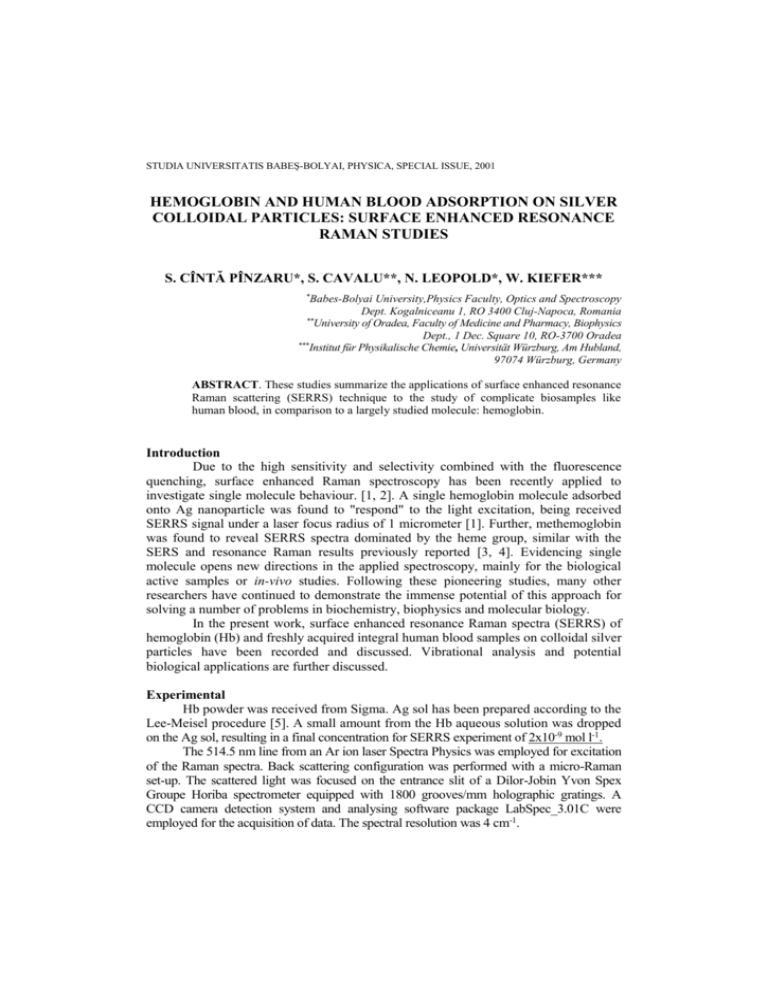
STUDIA UNIVERSITATIS BABEŞ-BOLYAI, PHYSICA, SPECIAL ISSUE, 2001 HEMOGLOBIN AND HUMAN BLOOD ADSORPTION ON SILVER COLLOIDAL PARTICLES: SURFACE ENHANCED RESONANCE RAMAN STUDIES S. CÎNTĂ PÎNZARU*, S. CAVALU**, N. LEOPOLD*, W. KIEFER*** *Babes-Bolyai University,Physics Faculty, Optics and Spectroscopy Dept. Kogalniceanu 1, RO 3400 Cluj-Napoca, Romania **University of Oradea, Faculty of Medicine and Pharmacy, Biophysics Dept., 1 Dec. Square 10, RO-3700 Oradea ***Institut für Physikalische Chemie, Universität Würzburg, Am Hubland, 97074 Würzburg, Germany ABSTRACT. These studies summarize the applications of surface enhanced resonance Raman scattering (SERRS) technique to the study of complicate biosamples like human blood, in comparison to a largely studied molecule: hemoglobin. Introduction Due to the high sensitivity and selectivity combined with the fluorescence quenching, surface enhanced Raman spectroscopy has been recently applied to investigate single molecule behaviour. [1, 2]. A single hemoglobin molecule adsorbed onto Ag nanoparticle was found to "respond" to the light excitation, being received SERRS signal under a laser focus radius of 1 micrometer [1]. Further, methemoglobin was found to reveal SERRS spectra dominated by the heme group, similar with the SERS and resonance Raman results previously reported [3, 4]. Evidencing single molecule opens new directions in the applied spectroscopy, mainly for the biological active samples or in-vivo studies. Following these pioneering studies, many other researchers have continued to demonstrate the immense potential of this approach for solving a number of problems in biochemistry, biophysics and molecular biology. In the present work, surface enhanced resonance Raman spectra (SERRS) of hemoglobin (Hb) and freshly acquired integral human blood samples on colloidal silver particles have been recorded and discussed. Vibrational analysis and potential biological applications are further discussed. Experimental Hb powder was received from Sigma. Ag sol has been prepared according to the Lee-Meisel procedure [5]. A small amount from the Hb aqueous solution was dropped on the Ag sol, resulting in a final concentration for SERRS experiment of 2x10-9 mol l-1. The 514.5 nm line from an Ar ion laser Spectra Physics was employed for excitation of the Raman spectra. Back scattering configuration was performed with a micro-Raman set-up. The scattered light was focused on the entrance slit of a Dilor-Jobin Yvon Spex Groupe Horiba spectrometer equipped with 1800 grooves/mm holographic gratings. A CCD camera detection system and analysing software package LabSpec_3.01C were employed for the acquisition of data. The spectral resolution was 4 cm-1. HEMOGLOBIN AND HUMAN BLOOD ADSORPTION ON SILVER COLLOIDAL PARTICLES Results and discussions It is known that the hemoglobin molecule presents a strong fluorescence background at the green light (514.5 nm) excitation. Conventional Raman technique being inadequate, SERRS technique overcomes such difficulties by quenching fluorescence (Fig 1). Raman Intensity/ arb. units 50000 e 40000 d 30000 c 20000 b 10000 a 1800 1600 1400 1200 1000 800 600 400 200 -1 Wavenumber/ cm Fig. 1. a) Raman spectrum of pure haemoglobin covered by a fluorescence background. SERS spectra of haemoglobin b) 36, c) 75, d) 360, e) 720 nmol/l concentration in Lee-Meisel Ag colloid. Excitation 514.5 nm, power 120 mW on the sample. A near-IR excitation with 1064 nm, which was previously used, could very well give rise to a certain degree of resonance enhancement [6], due to the several weak and broad optical absorption bands in the region 900-1100 nm. The presence of intense bands near 1370-1372 cm-1 HbF, metHb, hemin and its absence in NiHb and deoxyHb confirms this band to be a FT-Raman marker for Fe3+ [6]. The FT-Raman bands at 1370 and 1354 cm-1 in oxyHb and deoxyHb have been assigned to 4 in good agreement with previous reports [3, 6]. The other prominent FT-Raman bands observed in all derivatives of Hb, but absent in hemin, around 1000 cm-1 can be correlated to the phenyl mode of the aromatic amino acid residues in globin part of Hb. Other representative band observed around 1654 cm-1 for Hb derivatives, which is absent in 457 S. CÎNTĂ PÎNZARU, S. CAVALU, N. LEOPOLD, W. KIEFER hemin spectrum indicates that it is of globin origin [6]. This band is absent in the RR spectra of Hb derivatives spectra with visible excitation indicating non-resonant nature of globin moiety. Modification of the Ag colloid with chloride ions was unnecessary for obtaining the SERRS signal. This modification generated only the typical Ag-Cl mode at 244 cm-1 in the SERRS spectrum. According to the recent literature [1, 2], excitation with the 514.5 nm line leads to a SERRS spectrum characterised by three prominent haemoglobin bands: 1375, 1586, 1640 cm-1. These bands are called "markers" of the hemic group packed in the polipeptidic chain and are assigned to in plane vibrations of the porphyrine ring. The dominant SERRS bands (Fig. 1) are located at 1610, 1586, 1568 cm-1 being assigned to the C=C and C=N modes. The bands at 1375, 1167, cm-1 were assigned to = C-N, and C-H bending respectively. The out of plane porphyrine bending vibrations are located at 957, 761 and 674 cm-1 respectively. Increasing concentration of haemoglobin solution dropped in Ag sol, very good reproducibility of SERRS signal was observed. Once optimised the SERRS acquiring procedure, increasing concentration does not affect significantly the intensity of the SERRS signal. This fact reflects that the signal was received only from the first monolayer of adsorbed molecules, further added molecules being already too far to the SERS active surface which could be completely covered. However, by increasing concentration, we can notice a little modification in relative intensity of 1375 cm-1 band with respect to 1586-1610 cm-1 spectral range, meaning the enhancement of = C-N detrimental to the C=C and C=N modes. This observation suggests an electronic dellocalization of cromophore group. In the present case, the SERRS signal represents a double resonance contribution, first a plasmon resonance of the colloidal particles excited with green light, representing the electromagnetic contribution to the total enhancement and second, the pre-resonance contribution of hemoglobin excited with green light. Fig. 2 presents the absorption spectrum of haemoglobin aqueous solution together with the human blood, in order to have a better eye-guide of the laser line position near the Soret band (420 nm). Hence, the total amplification is greater than the usual SERS amplification due to the well-known mechanisms (EM and CT). These results are in agreement with the previous report of oxihemoglobin adsorbed onto colloidal silver [7]. SERRS spectrum of integral human blood was successfully obtained and compared to that one of haemoglobin (Fig. 3 b, a). A time dependence study was also carried out (Fig. 3 b-e). A small amount of human blood freshly isolated was dropped into 2.5 ml Ag sol resulting a rapid change in colloid colour. The SERRS sample was putted under laser excitation and different acquiring times were employed successively. The main hemoglobin marker bands (1610, 1586, 1568, 1375, 1167, 957, 761 and 674 cm-1) were observed in all the SERRS spectra of blood, even if some little changes in relative intensities are observed in the 1375-1586 cm-1 spectral range. Those changes are probably due to the photo- or thermal-induced coagulation of blood. Further oxidation of blood lead to the transition from oxihemoglobin (Fe2+) to methemoglobin (Fe3+) with a dellocalization of iron from porphyrine plane. 458 HEMOGLOBIN AND HUMAN BLOOD ADSORPTION ON SILVER COLLOIDAL PARTICLES Absorbance/ arb.units 3 2 1 hemoglobine blood 0 400 500 600 700 Wavelength / nm Fig. 2. Absorption spectra of hemoglobin and freshly isolated human blood. 1382 1586 1567 20000 761 683 1178 e d 10000 c 5000 b 1375 Raman Intensity/ arb. units 15000 a 0 1800 1600 1400 1200 1000 800 600 400 200 -1 Wavenumber/ cm Fig. 3. Time evolution SERRS spectra of human blood (b) 10 s, c) 100 s, d) 200 s, e) 300 s acqiring time, in comparison to the SERRS spectrum of pure hemoglobin (a). 459 S. CÎNTĂ PÎNZARU, S. CAVALU, N. LEOPOLD, W. KIEFER Hence, SERRS technique was employed as a very important tool for detecting small amounts of hemoglobin (nano-, picomolar concentrations and even lower) in complicate biosamples, due to its high selectivity and huge enhancement of the Raman signal, combined with (pre-) resonance amplification contribution of a defined species from a biological mixture. Conclusions Surface enhanced resonance Raman spectra of hemoglobin have been recorded and compared to those of human blood. The SERRS signal of hemoglobin was found to be independent on the increasing concentration after attempting the monolayer coverage. SERRS spectra of the human blood reveal the same hemoglobin marker bands, emphasising the high selectivity of this technique for complicate biosamples. Acknowledgement. Financial support from Grant T 131 BM is highly acknowledged. R E FER EN CE S 1. 2. 3. 4. 5. 6. K. Kneipp, H. Kneipp, I. Itzkan, R.R. Dasari, M. S. Feld, Chem. Rew. 1999, 99, 2957-2975. Hongxing Xu, Erik J. Bjerneld, M. Kall, L. Börjesson, Phys. Rew. Lett., 83, 21, 1999, 4357. T. G. Spiro, T. C. Strekas, J. Am. Chem. Soc. 1974, 96, 338. H. Brunner, H. Sussner, Biohim. Biophys. Acta, 310, 1973, 20-31. P. C. Lee, D. Meisel, J. Phys. Chem., 1982, 86, 3391. M. Mylrajan, Proceedings of the XVIIth International Conference on Raman Spectroscopy 2000, Eds., J. Wiley &Sons, Ltd, Chichester, New-York, Weinheim, p.956. 7. J. de Groot, R. E. Hester, J. Phys. Chem., 91, 1987, 1694. 460
